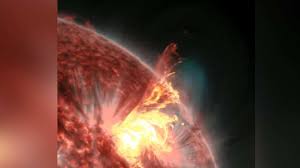Captivating Solar Flare
The Marvelous Display
On Monday (June 3), the sun treated us to a mesmerizing show as it unleashed an intense solar flare, which was meticulously documented by NASA’s solar observatory.
A Closer Look
However, upon closer examination of the eruption, it becomes apparent that a significant portion of the solar material within the vast plasma plume failed to escape the sun’s gravitational pull. In a captivating video captured by NASA’s Solar Dynamics Observatory during an M-class solar flare, we witness a grand plasma plume ascend from the sun’s surface, only to be drawn back in, resembling a “failed eruption.”
Insight from Astrophysicist Ryan French
Understanding the Phenomenon
Renowned solar astrophysicist Ryan French shed light on this remarkable event, which unfolded at 10:11 a.m. EDT (1411 GMT) on Monday. Taking to social media, French described the solar flare as “gorgeous” and highlighted the fascinating dynamics of falling plasma interacting with the magnetic field. As further data emerged, it became evident that this event serves as a prime example of a “failed eruption,” wherein solar material attempted to escape but was thwarted by the sun’s immense gravitational force.
The solar flare witnessed on Monday showcased the awe-inspiring power and intricacies of our sun. Despite the spectacle, the phenomenon of a “failed eruption” reminds us of the sun’s dominance and the delicate balance of forces governing our solar system.








